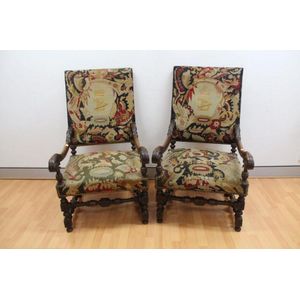William Morris Inspired Upholstered Armchair and Footstool
You must be a subscriber, and be logged in to view price and dealer details.
Subscribe Now to view actual auction price for this item
When you subscribe, you have the option of setting the currency in which to display prices to $Au, $US, $NZ or Stg.
- Turning - Any part of a piece of furniture that has been turned and shaped with chisels on a lathe. Turned sections include legs, columns, feet, finials, pedestals, stretchers, spindles etc. There have been many varieties and fashions over the centuries: baluster, melon, barley-sugar, bobbin, cotton-reel, rope-twist, and so on. Split turning implies a turned section that has been cut in half lengthwise and applied to a cabinet front as a false decorative support.
- Proportions - Essentially, the size of the various parts of a piece of furniture in relation to the whole. Ideally, the proportions should be pleasing to the eye appearing neither top-heavy nor unbalanced and convenient for ordinary use.
- Morris, William - William Morris (1834 - 1896) an architect designer, artist, writer, poet and social activist is regarded as a leader of the Arts & Crafts movement in England.
After studying theology, ecclesiastical history, medieval poetry and art at Oxford University, Morris began work with a firm of architects for a short period.
In 1861 he formed a company Morris Marshall, Faulkner & Co. was formed to design and produce wallpaper, carpets, tapestries and stained glass, and they initially secured ecclesiastical works, later extending to domestic assignments.
In 1874 he took sole control of the company, buying out the other partners, and renaming it Morris & Co.
The origins of his designs can be traced to medieval Gothic styles but his organic flower and bird motifs encouraged later artists to seek inspiration for their designs in nature. - Turned Legs - are legs which have been turned on a lathe. In use from the 16th century, turned legs on tables, chairs and cabinets became more frequent until, by the 1830s, the Georgian square or tapered leg was rarely found except in country pieces.
- Circa - A Latin term meaning 'about', often used in the antique trade to give an approximate date for the piece, usually considered to be five years on either side of the circa year. Thus, circa 1900 means the piece was made about 1900, probably between 1895 and 1905. The expression is sometimes abbreviated to c.1900.
- Bun Feet - Similar to ball feet, though somewhat compressed or flattened in appearance. Introduced during the late 17th century, but they have been used on furniture up to the present day.
- Lopers - Wooden slides which are concealed just below the hinged front of a drop front bureau or desk, and when pulled out, support the open desk flap in the horizontal position.
This item has been included into following indexes:
-
chairs, singles / pairs / threes, style or period
- armchairs 1,767
- elm 234
- William IV 123
- Morris, William (Morris & Co.) (England) - furniture, designers and makers 26
Visually similar items

A good George III style oak and upholstered wing back chair. together with a small oak footstool

A fine pair of tapestry covered Louis XIII style carvers, the generous chairs of square back form with curvaceous arms with turned supports to square stuffover seats raised on turned and block legs with conforming 'H' form stretchers; superbly upholstered

Pair of antique French Louis XIV highback armchairs, carved walnut leaf capped arms (2)

A fine pair of French carved walnut and floral tapestry upholstered armchairs
